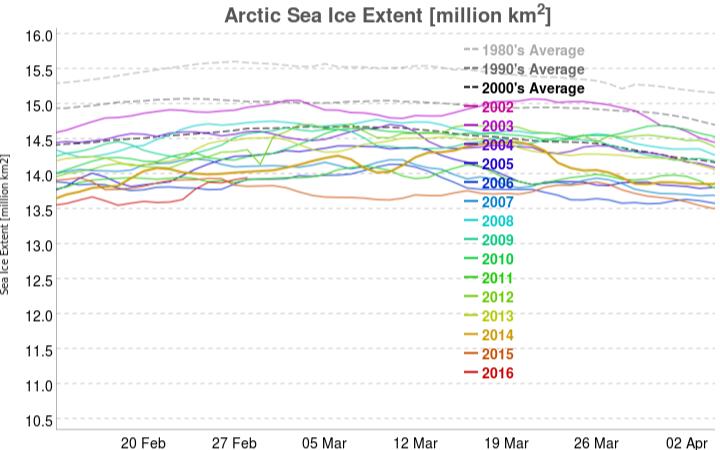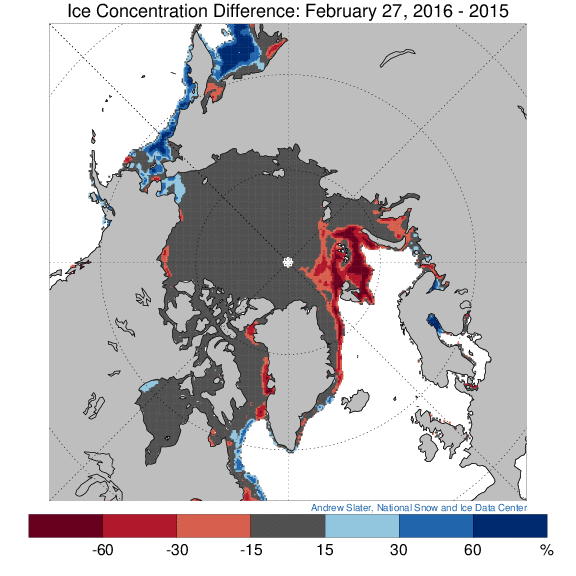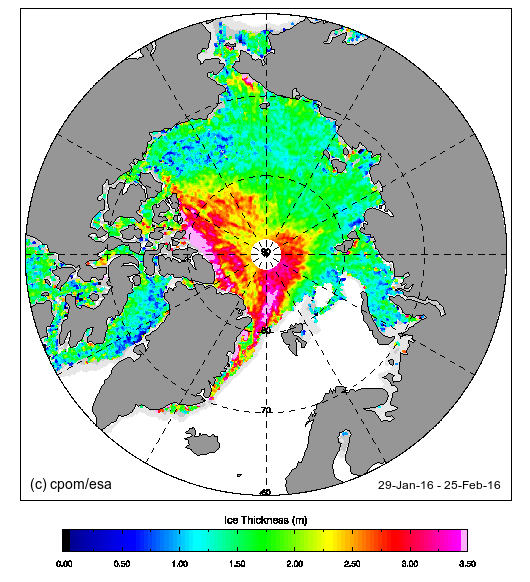Professor Judith Curry recently posed the following rhetorical question on her “Climate Etc.” blog:
Arctic sea ice extent has been anomalously low this winter. The greatest anomalies are in the European sector, specifically in the Barents Sea. To what extent are the anomalies associated with warm temperatures?
Which she answered as follows:
So, what might be causing this particular anomaly? Some possibilities are:
-
Gobal warming (January 2016 was warmest Jan on record, according to the surface temperature analyses
-
Multidecadal oscillations (e.g. stadium wave) predicts ice recovery to be occurring in the same region (European Arctic) where we see the sea ice decline).
-
Seasonal weather circulation patterns – this has been a year with with unusual weather patterns, with both low temperature and high temperature records being set.
As regular readers will already be aware we have been blogging about anomalously warm temperatures in the Arctic all year and so felt well qualified to contribute to the “debate”. What a job that turned out to be! Early on in the proceedings the anticipated pronouncement was made by one of Judith’s “denizens”. A link to a ludicrously inaccurate article on Watts Up With That accompanied by the following words of wisdom:
Other measures are high.
Which of course they aren’t! Instead of stating the bleedin’ obvious Professor Curry replied:
I spotted this, no idea what to make of it.
You would think she and her denizens would therefore have been pleased when I attempted to explain to her what to make of it, but you would have been mistaken. The icing on the ad hominem cake was the aforementioned Anthony Watts driving by to accuse me of all sorts of nefarious activities without providing a single shred of evidence and then running for the hills when invited to actually prove his ludicrous allegations.
Since the denizens of “Climate Etc.” aren’t particularly interested let’s take stock here instead shall we? After every Arctic area and extent metric under the sun sitting at “lowest *ever” levels for weeks a recent increase in coverage on the Pacific side of the Arctic has changed that. The most up to date example of that is the JAXA/ADS extent, which currently looks like this:
The latest reading is the merest whisker above 2015’s record low maximum. However in other respects things are most certainly not comparable with 2015. See for example this concentration comparison from Andrew Slater of the NSIDC:
Much more ice on the Pacific periphery where it will all have disappeared by September, as opposed to much less ice on the Atlantic side, even well to the north of 80 degrees latitude where the sun still does not shine. Here’s a video revealing how the sea ice North of the Pacific Ocean has been reacting to the sequence of hurricane force storms that have been passing through the area over the past couple of months:
Now let’s take a look at “near real time” Arctic sea ice thickness as measured by the CryoSat 2 satellite:
Notice the absence of any thick ice in the Beaufort and Chukchi Seas, an obvious difference from last year? Notice too the large area of thick ice that looks as though it’s heading towards the Fram strait exit from the Central Arctic. Here’s another video, this time of sea ice movement over on the Atlantic side of the Arctic Ocean:
Those dark areas between Svalbard and the North Pole are suddenly starting to look as though they represent reality rather than a mere “artifact”, although perhaps they are merely transient evidence of yet another Arctic “heat wave”?



The latest edition of Arctic Sea Ice News is out:
As we suggested above:
Assorted extent metrics are currently toying with all time lows for the date. Here’s NSIDC extent for example:
However Cryosphere Today Arctic sea ice area is currently unequivoval:
The February PIOMAS Arctic sea ice volume numbers have been released at long last:
The daily data shows 20.660 thousand km3 for 2016 day 60, compared to the “lowest *ever” level of 20.546 for day 60 of 2011.
I am only a humble learner at ASIB and ASIF and have a sincere question.
Given what we know of past pauses in the decline of ice volume, is it safe to say that volume could be decimated if the Arctic is subjected to another “perfect storm summer” similar to 2013?
clean-up aisle three…
correction…2012
I suddenly have this strange feeling of déjà vu. In answer to your question, here’s another one!
How do you define “decimated”?
If it’s “less than September 2012” that is certainly feasible given that all the sea ice metrics are currently lower than on the same day of 2012. Not by a lot though. What with one thing and another I have to admit that I haven’t had a chance to compare snow cover yet though.
In addition the Beaufort Sea is lacking the thick ice of last year, currently at least. Nonetheless there’s still lots of that north of Greenland and the CAA, which will take lots of energy to melt.
Why don’t you try posing your question again in 3 months time?
Decimated was referring to a similar percent loss in volume as compared with 2012, not the net volume of ice loss.
Northern Hemisphere snow extent is currently well below 2012 levels:
That being the case, and pending reevaluation in June of course, it is certainly not beyond the bounds of possibility that by September 2016 the sea ice in the Arctic will be at least as “decimated” as it was in 2012.
Here’s an alternative visualisation of the February 2016 PIOMAS Arctic sea ice volume numbers. Andy Lee Robinson’s (in)famous “Arctic Death Spiral“:
More visualisations hot off the virtual presses. PIOMAS gridded Arctic sea ice thickness for February 29th 2016:
Plus CryoSat 2 thickness for the 28 days finishing March 7th 2016:
We’ve made a bold prediction over on Twitter!
Here’s the current state of play this morning (UTC):
Day 1 has worked out much as predicted:
12.885 million square kilometres. Can you see the big drop for last year (red line) in the middle of March? Expect the same tomorrow!
The big drop we predicted for day 75 came to pass, and Cryosphere Today Arctic sea ice area is currently still clearly below all previous years in their record going back to 1979, as well as the 12.885 million square kilometres maximum for 2016:
CT area has dropped again today. The chances of the current 2016 maximum being exceeded are rapidly tending to zero. Assuming the current maximum holds, here’s the CT area trend: